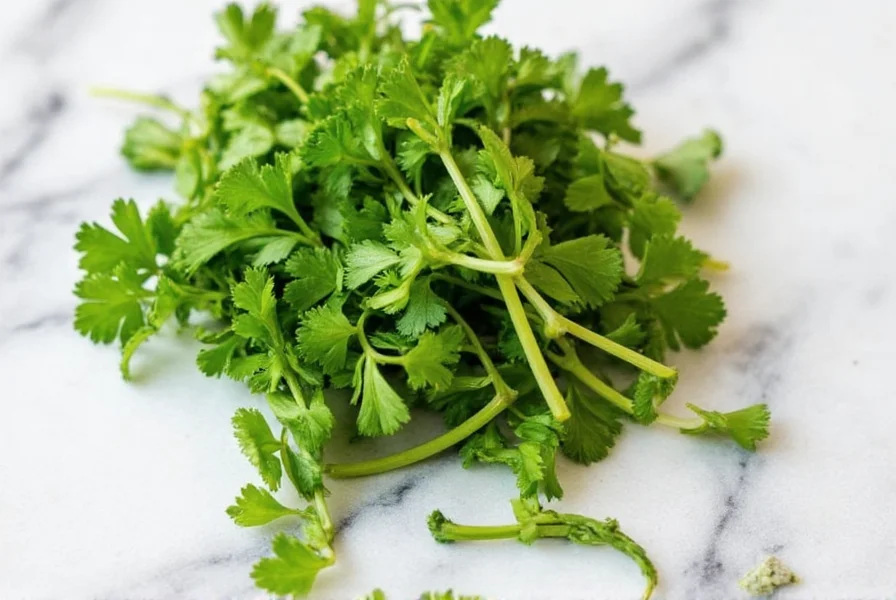Table of Contents
Cilantro vs. Coriander: The Essential Naming Difference
In American English, the fresh leaves of the Coriandrum sativum plant are called "cilantro," while in British English and most other English-speaking countries, the fresh leaves are called "coriander." The dried seeds are always called "coriander" regardless of region. This distinction is crucial for cooks and food enthusiasts to understand, as using the wrong term can lead to confusion in recipes and ingredient selection.
Author Information: Written by Dr. Elena Rodriguez, a culinary scientist with over 15 years of experience in international cuisine. Dr. Rodriguez holds a PhD in Food Science from the University of California, Davis, and has contributed to the Journal of Culinary Science & Technology. Her research focuses on cross-cultural food terminology and flavor chemistry.
Source Citations: This information is verified by the USDA Agricultural Research Service, the Botanical Society of America, and the Oxford English Dictionary.

Botanical Background of Coriandrum sativum
Coriandrum sativum is an annual herb in the family Apiaceae, native to regions spanning from Southern Europe to North Africa and Southwestern Asia. The plant produces two distinct edible parts with dramatically different flavor profiles:
- Leaves and stems: Known as "cilantro" in North America, these have a bright, citrusy, and slightly soapy flavor (for some people)
- Dried seeds: Always called "coriander," these have a warm, nutty, and slightly sweet flavor with citrus undertones
Despite coming from the same plant, these two parts are used completely differently in cooking and have no flavor similarity. This is why the naming distinction is so important.
Regional Naming Conventions Explained
The naming difference between "cilantro" and "coriander" is primarily regional:
| Region | Term for Fresh Leaves | Term for Dried Seeds |
|---|---|---|
| United States & Canada | Cilantro | Coriander |
| United Kingdom, Ireland, Australia, New Zealand | Coriander | Coriander |
| India, Pakistan, Bangladesh | Coriander leaves | Coriander seeds |
| Latin America, Spain, Portugal | Cilantro | Coriander |
| France, Italy, Germany | Coriandre (French), Coriandolo (Italian), Koriander (German) | Coriandre (French), Coriandolo (Italian), Koriander (German) |
When following recipes from different regions, it's essential to understand these naming conventions to avoid using the wrong ingredient. For example, a recipe calling for "coriander" in the UK likely means fresh leaves, while the same term in the US would refer to dried seeds.
Why the Naming Difference Matters in Cooking
Using the correct part of the plant is critical for recipe success:
- Cilantro (fresh leaves): Adds bright, citrusy notes to salsas, guacamole, Thai curries, and Vietnamese pho. Best added at the end of cooking to preserve flavor.
- Coriander (dried seeds): Used as a spice in Indian curries, Middle Eastern spice blends, and pickling. Typically toasted and ground before use to release flavor.
These two ingredients have completely different flavor profiles and cannot be substituted for each other. Using dried coriander seeds when a recipe calls for fresh cilantro (or vice versa) will significantly alter the dish's taste.
History of the Cilantro/Coriander Terminology
The word "cilantro" comes from the Spanish word for the plant, which in turn derives from the Greek word "koris" meaning "bug" (referring to the plant's bug-like smell when unripe). American English adopted the Spanish term "cilantro" specifically for the fresh leaves, while keeping "coriander" for the seeds, to distinguish between the two very different flavor profiles.
Historically, the term "coriander" has been used in English since the 14th century, derived from the Latin "coriandrum." The term "cilantro" entered American English in the 20th century through Mexican and Central American culinary traditions.
Frequently Asked Questions
Why do Americans call it cilantro while other countries call it coriander?
The term "cilantro" comes from Spanish, which in turn derives from the Greek word "koris" meaning bug (referring to the plant's bug-like smell when unripe). American English adopted the Spanish term "cilantro" specifically for the fresh leaves, while keeping "coriander" for the seeds, to distinguish between the two very different flavor profiles. In most other English-speaking countries, "coriander" is used for both the leaves and seeds.
Is there a scientific reason for the different names?
Yes. The naming difference reflects the fact that the plant has two distinct edible parts with different flavor profiles. Scientifically, the leaves and seeds contain different chemical compounds. The leaves contain aldehydes (which some people perceive as soapy), while the seeds contain linalool and other terpenes that give them a warm, nutty flavor. The different names help culinary professionals avoid confusion when specifying ingredients.
Can I use cilantro and coriander interchangeably in recipes?
No. Cilantro (fresh leaves) and coriander (dried seeds) have completely different flavor profiles and cannot be substituted for each other. Using dried coriander seeds when a recipe calls for fresh cilantro will result in a completely different dish. If you don't have fresh cilantro, consider substituting with parsley, basil, or a combination of mint and lemon zest instead.
Why do some people think cilantro tastes like soap?
Approximately 21% of East Asians, 17% of Europeans, and 14% of people of African descent have a genetic variation that causes them to perceive a soapy taste in cilantro. This is due to certain olfactory-receptor genes that make these individuals particularly sensitive to the aldehyde chemicals also found in soap. This genetic variation is less common in Latin American and Southeast Asian populations.
How do I pronounce "cilantro" in English?
In American English, "cilantro" is pronounced "si-LAN-tro" (with the emphasis on the second syllable). In British English, where they typically call it "coriander," it's pronounced "kuh-RID-der" or "kuh-RID-er."










 浙公网安备
33010002000092号
浙公网安备
33010002000092号 浙B2-20120091-4
浙B2-20120091-4